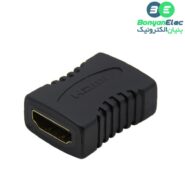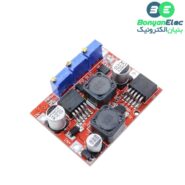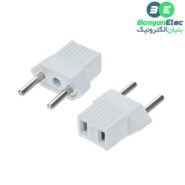ماژول مبدل آنالوگ به دیجیتال 16 بیتی 4 کاناله ADS1115 با قابلیت پروگرام
معرفی :
ماژول ADS1115 در زمینه تبدیل خروجی های آنالوگ به دیجیتال یکی از پرکاربرد ترین و قوی ترین ماژول ها در رده های هم سطح و هم قیمت خود است. بوسیله این ماژول می توانید خروجی میکروکنترلرهای آنالوگ خود را به خروجی دیجیتال تبدیل کنید. این ماژول دارای اسیلاتور داخلی و Auto shut-down و Internal reference می باشد. این ماژول یک مبدل 4 کاناله آنالوگ به دیجیتال با دقت 16بیت می باشد که از پروتکل i2c پشتیبانی می کند. از جمله کاربرد ها این ماژول می توان به استفاده در سنسورهای مختلف مانند سنسورهای دما، ولتمتر ، اتوماسیون و کنترل خانه هوشمند، ابزار قابل حمل، مانیتور باتری و … اشاره کرد. پروتکل i2c پروتکل استاندارد با دو سیم بوده که بدین منظور از پایه های SCL/SDA جهت اتصال به میکروکنترلر استفاده می شود. ورودی ماژول از تکنولوژی مالتی پلکسر پشتیبانی کرده که بدین طریق می توان از4 کانال مجزا یا دو کانال بصورت تفاضلی استفاده کرد.
مشخصات :
- محدوده دمای کاری: 125+ ~ 40-
- ولتاژ: 2 تا 5.5 ولت
- جریان: 150uA
- رزولوشن: 16 بیت
- نوع ارتباط: I2C
- تعداد کانالها: 4 کانال
- نوع تبدیل: مبدل آنالوگ به دیجیتال
- از ویژگی های دیگر این ماژول می توان به منبع مرجع داخلی اشاره کرد که یک ولتاژ ثابت داخلی به منظور تعیین ولتاژ مرجع توسط ماژول ساخته می شود.
: Product Description
For microcontrollers without an analog-to-digital converter or when you want a higher-precision ADC, the ADS1115 provides 16-bit
precision at 860 samples/second over I2C. The chip can be configured as 4 single-ended input channels, or two differential channels. As a
nice bonus, it even includes a programmable gain amplifier, up to x16, to help boost up smaller single/differential signals to the full range.
We like this ADC because it can run from 2V to 5V power/logic, can measure a large range of signals and its super easy to use. It is a great
general purpose 16 bit converter. The chip’s fairly small so it comes on a breakout board with ferrites to keep the AVDD and AGND quiet.
Interfacing is done via I2C. The address can be changed to one of four options (see the datasheet table 5) so you can have up to 4
ADS1115’s connected on a single 2-wire I2C bus for 16 single ended inputs. To get you started, we have example code for both the
Raspberry Pi (in the Adafruit Pi Python library) and Arduino (in the ADS1X15 Arduino library repository) Simply connect GND to ground,
. VDD to your logic power supply, and SCL/SDA to your microcontroller’s I2C port and run the example code to start reading data
: TECHNICAL DETAILS
WIDE SUPPLY RANGE: 2.0V to 5.5V
LOW CURRENT CONSUMPTION: Continuous Mode: Only 150µA Single-Shot Mode: Auto Shut-Down
PROGRAMMABLE DATA RATE: 8SPS to 860SPS
INTERNAL LOW-DRIFT VOLTAGE REFERENCE
INTERNAL OSCILLATOR
INTERNAL PGA
I2C INTERFACE: Pin-Selectable Addresses
FOUR SINGLE-ENDED OR TWO DIFFERENTIAL INPUTS
PROGRAMMABLE COMPARATOR
This board/chip uses I2C 7-bit addresses between 0x48-0x4B, selectable with jumpers.
To get you started, Simply connect GND to ground, VDD to your logic power supply, and SCL/SDA to your microcontroller’s I2C port and run the example code to start reading data.
برای ثبت دیدگاه، لازم است ابتدا وارد حساب کاربری خود شوید. اگر این محصول را قبلا از این فروشگاه خریده باشید، دیدگاه شما به عنوان مالک محصول ثبت خواهد شد.
هنوز پرسشی ثبت نشده است.
ثبت پرسش جدید
برای ثبت پرسش، لازم است ابتدا وارد حساب کاربری خود شوید
به این پرسش پاسخ دهید
برای ثبت پرسش، لازم است ابتدا وارد حساب کاربری خود شوید








دیدگاهها0
هیچ دیدگاهی برای این محصول نوشته نشده است.